Bergamot Polyphenols Reduce Hepatic Lipogenesis While Boosting Autophagy and Short-Chain Fatty Acid Production in a Murine “Cafeteria” Model of MASLD
Abstract
1. Introduction
2. Materials and Methods
2.1. Animal Procedures and Experimental Design
2.2. Blood Analysis and Total Liver Lipids Quantification
2.3. Histology and Histochemistry of Mouse Liver Sections
2.4. Liver Sample Preparation and Western Blotting (WB)
2.5. Quantitative (q)RT-PCR Analysis
2.6. Analysis of Short-Chain Fatty Acids (SCFAs)
2.7. Statistical Analysis
3. Results
3.1. Effects of BPF on Parameters Associated with CAF Diet-Induced MASLD in Mice
3.2. BPF Attenuates Hepatic Histopathological Alterations Characteristic of NAFLD and NASH in Murine CAF Model of MASLD
3.3. BPF-Induced Effects on Autophagy and Lipid Metabolism in Murine CAF Model of MASLD
3.4. Bergamot Polyphenols Reduce but Do Not Suppress Lipogenesis Genes in CAF Mice Liver
3.5. Effects of BPF on Caecal SCFAs Production in CAF-Fed Mice
4. Discussion and Conclusions
Supplementary Materials
Author Contributions
Funding
Institutional Review Board Statement
Data Availability Statement
Acknowledgments
Conflicts of Interest
References
- Younossi, Z.; Anstee, Q.M.; Marietti, M.; Hardy, T.; Henry, L.; Eslam, M.; George, J.; Bugianesi, E. Global burden of NAFLD and NASH: Trends, predictions, risk factors and prevention. Nat. Rev. Gastroenterol. Hepatol. 2018, 15, 11–20. [Google Scholar] [CrossRef]
- Kleiner, D.E. Histopathology, grading and staging of nonalcoholic fatty liver disease. Minerva Gastroenterol. Dietol. 2018, 64, 28–38. [Google Scholar] [CrossRef]
- Portincasa, P.; Baffy, G. Metabolic dysfunction-associated steatotic liver disease: Evolution of the final terminology. Eur. J. Intern. Med. 2024, 124, 35–39. [Google Scholar] [CrossRef] [PubMed]
- Ruan, S.; Huang, L.; Song, J.; Yi, Z.; Sun, W.; Zhou, F.; Feng, C.; Du, G.; Xie, J.; Lu, Y.; et al. Global burden trends and forecasts for MAFLD in adolescents and young adults from 1990 to 2021. Sci. Rep. 2025, 15, 13534. [Google Scholar] [CrossRef] [PubMed]
- Younossi, Z.M.; Golabi, P.; Paik, J.M.; Henry, A.; Van Dongen, C.; Henry, L. The global epidemiology of nonalcoholic fatty liver disease (NAFLD) and nonalcoholic steatohepatitis (NASH): A systematic review. Hepatology 2023, 77, 1335–1347. [Google Scholar] [CrossRef] [PubMed]
- Meroni, M.; Longo, M.; Rustichelli, A.; Dongiovanni, P. Nutrition and Genetics in NAFLD: The Perfect Binomium. Int. J. Mol. Sci. 2020, 21, 2986. [Google Scholar] [CrossRef]
- Jimenez-Gonzalez, C.; Alonso-Pena, M.; Argos Velez, P.; Crespo, J.; Iruzubieta, P. Unraveling MASLD: The Role of Gut Microbiota, Dietary Modulation, and AI-Driven Lifestyle Interventions. Nutrients 2025, 17, 1580. [Google Scholar] [CrossRef]
- Philip Esteban, J.; Dinani, A. Lifestyle Interventions Beyond Diet and Exercise for Patients With Nonalcoholic Fatty Liver Disease. Gastroenterol. Hepatol. 2020, 16, 119–130. [Google Scholar]
- Gonzalez-Gomez, A.; Cantone, M.; Garcia-Munoz, A.M.; Victoria-Montesinos, D.; Lucas-Abellan, C.; Serrano-Martinez, A.; Munoz-Morillas, A.M.; Morillas-Ruiz, J.M. Effect of Polyphenol-Rich Interventions on Gut Microbiota and Inflammatory or Oxidative Stress Markers in Adults Who Are Overweight or Obese: A Systematic Review and Meta-Analysis. Nutrients 2025, 17, 2468. [Google Scholar] [CrossRef]
- Parafati, M.; Lascala, A.; La Russa, D.; Mignogna, C.; Trimboli, F.; Morittu, V.M.; Riillo, C.; Macirella, R.; Mollace, V.; Brunelli, E.; et al. Bergamot Polyphenols Boost Therapeutic Effects of the Diet on Non-Alcoholic Steatohepatitis (NASH) Induced by “Junk Food”: Evidence for Anti-Inflammatory Activity. Nutrients 2018, 10, 1604. [Google Scholar] [CrossRef]
- Capomolla, A.S.; Janda, E.; Paone, S.; Parafati, M.; Sawicki, T.; Mollace, R.; Ragusa, S.; Mollace, V. Atherogenic Index Reduction and Weight Loss in Metabolic Syndrome Patients Treated with A Novel Pectin-Enriched Formulation of Bergamot Polyphenols. Nutrients 2019, 11, 1271. [Google Scholar] [CrossRef]
- Janda, E.; Lascala, A.; Martino, C.; Ragusa, S.; Nucera, S.; Walker, R.; Gratteri, S.; Mollace, V. Molecular mechanisms of lipid- and glucose-lowering activities of bergamot flavonoids. PharmaNutrition 2016, 4, S8–S18. [Google Scholar] [CrossRef]
- Parafati, M.; La Russa, D.; Lascala, A.; Crupi, F.; Riillo, C.; Fotschki, B.; Mollace, V.; Janda, E. Dramatic Suppression of Lipogenesis and No Increase in Beta-Oxidation Gene Expression Are among the Key Effects of Bergamot Flavonoids in Fatty Liver Disease. Antioxidants 2024, 13, 766. [Google Scholar] [CrossRef]
- Siqueira, J.S.; Vieira, T.A.; Nakandakare-Maia, E.T.; Palacio, T.L.N.; Sarzi, F.; Garcia, J.L.; de Paula, B.H.; Bazan, S.G.Z.; Baron, G.; Tucci, L.; et al. Bergamot leaf extract treats cardiorenal metabolic syndrome and associated pathophysiological factors in rats fed with a high sugar fat diet. Mol. Cell Endocrinol. 2022, 556, 111721. [Google Scholar] [CrossRef]
- Mollace, V.; Sacco, I.; Janda, E.; Malara, C.; Ventrice, D.; Colica, C.; Visalli, V.; Muscoli, S.; Ragusa, S.; Muscoli, C.; et al. Hypolipemic and hypoglycaemic activity of bergamot polyphenols: From animal models to human studies. Fitoterapia 2011, 82, 309–316. [Google Scholar] [CrossRef]
- Baron, G.; Altomare, A.; Mol, M.; Garcia, J.L.; Correa, C.; Raucci, A.; Mancinelli, L.; Mazzotta, S.; Fumagalli, L.; Trunfio, G.; et al. Analytical Profile and Antioxidant and Anti-Inflammatory Activities of the Enriched Polyphenol Fractions Isolated from Bergamot Fruit and Leave. Antioxidants 2021, 10, 141. [Google Scholar] [CrossRef] [PubMed]
- Formisano, C.; Rigano, D.; Lopatriello, A.; Sirignano, C.; Ramaschi, G.; Arnoldi, L.; Riva, A.; Sardone, N.; Taglialatela-Scafati, O. Detailed Phytochemical Characterization of Bergamot Polyphenolic Fraction (BPF) by UPLC-DAD-MS and LC-NMR. J. Agric. Food Chem. 2019, 67, 3159–3167. [Google Scholar] [CrossRef] [PubMed]
- Parafati, M.; Lascala, A.; Morittu, V.M.; Trimboli, F.; Rizzuto, A.; Brunelli, E.; Coscarelli, F.; Costa, N.; Britti, D.; Ehrlich, J.; et al. Bergamot polyphenol fraction prevents nonalcoholic fatty liver disease via stimulation of lipophagy in cafeteria diet-induced rat model of metabolic syndrome. J. Nutr. Biochem. 2015, 26, 938–948. [Google Scholar] [CrossRef]
- Sampey, B.P.; Vanhoose, A.M.; Winfield, H.M.; Freemerman, A.J.; Muehlbauer, M.J.; Fueger, P.T.; Newgard, C.B.; Makowski, L. Cafeteria diet is a robust model of human metabolic syndrome with liver and adipose inflammation: Comparison to high-fat diet. Obesity 2011, 19, 1109–1117. [Google Scholar] [CrossRef]
- Lalanza, J.F.; Snoeren, E.M.S. The cafeteria diet: A standardized protocol and its effects on behavior. Neurosci. Biobehav. Rev. 2021, 122, 92–119. [Google Scholar] [CrossRef]
- Lascala, A.; Martino, C.; Parafati, M.; Salerno, R.; Oliverio, M.; Pellegrino, D.; Mollace, V.; Janda, E. Analysis of proautophagic activities of Citrus flavonoids in liver cells reveals the superiority of a natural polyphenol mixture over pure flavones. J. Nutr. Biochem. 2018, 58, 119–130. [Google Scholar] [CrossRef]
- Palacio, T.L.N.; Siqueira, J.S.; de Paula, B.H.; Rego, R.M.P.; Vieira, T.A.; Baron, G.; Altomare, A.; Ferron, A.J.T.; Aldini, G.; Kano, H.T.; et al. Bergamot (Citrus bergamia) leaf extract improves metabolic, antioxidant and anti-inflammatory activity in skeletal muscles in a metabolic syndrome experimental model. Int. J. Food Sci. Nutr. 2023, 74, 64–71. [Google Scholar] [CrossRef]
- Musolino, V.; Gliozzi, M.; Scarano, F.; Bosco, F.; Scicchitano, M.; Nucera, S.; Carresi, C.; Ruga, S.; Zito, M.C.; Maiuolo, J.; et al. Bergamot Polyphenols Improve Dyslipidemia and Pathophysiological Features in a Mouse Model of Non-Alcoholic Fatty Liver Disease. Sci. Rep. 2020, 10, 2565. [Google Scholar] [CrossRef] [PubMed]
- Asgharpour, A.; Sanyal, A.J. Generation of a Diet-Induced Mouse Model of Nonalcoholic Fatty Liver Disease. Methods Mol. Biol. 2022, 2455, 19–30. [Google Scholar] [CrossRef] [PubMed]
- Karimkhanloo, H.; Keenan, S.N.; Bayliss, J.; De Nardo, W.; Miotto, P.M.; Devereux, C.J.; Nie, S.; Williamson, N.A.; Ryan, A.; Watt, M.J.; et al. Mouse strain-dependent variation in metabolic associated fatty liver disease (MAFLD): A comprehensive resource tool for pre-clinical studies. Sci. Rep. 2023, 13, 4711. [Google Scholar] [CrossRef] [PubMed]
- Weitkunat, K.; Schumann, S.; Nickel, D.; Kappo, K.A.; Petzke, K.J.; Kipp, A.P.; Blaut, M.; Klaus, S. Importance of propionate for the repression of hepatic lipogenesis and improvement of insulin sensitivity in high-fat diet-induced obesity. Mol. Nutr. Food Res. 2016, 60, 2611–2621. [Google Scholar] [CrossRef] [PubMed]
- Bortolin, R.C.; Vargas, A.R.; Gasparotto, J.; Chaves, P.R.; Schnorr, C.E.; Martinello, K.B.; Silveira, A.K.; Rabelo, T.K.; Gelain, D.P.; Moreira, J.C.F. A new animal diet based on human Western diet is a robust diet-induced obesity model: Comparison to high-fat and cafeteria diets in term of metabolic and gut microbiota disruption. Int. J. Obes. 2018, 42, 525–534. [Google Scholar] [CrossRef]
- Weitkunat, K.; Schumann, S.; Petzke, K.J.; Blaut, M.; Loh, G.; Klaus, S. Effects of dietary inulin on bacterial growth, short-chain fatty acid production and hepatic lipid metabolism in gnotobiotic mice. J. Nutr. Biochem. 2015, 26, 929–937. [Google Scholar] [CrossRef]
- Weitkunat, K.; Bishop, C.A.; Wittmuss, M.; Machate, T.; Schifelbein, T.; Schulze, M.B.; Klaus, S. Effect of Microbial Status on Hepatic Odd-Chain Fatty Acids Is Diet-Dependent. Nutrients 2021, 13, 1546. [Google Scholar] [CrossRef]
- den Elzen, C.C.M.; Carvalho, A.; Bazan-Socha, S.; Jeurink, P.V.; Wygrecka, M.; Kool, M.; Garssen, J.; Potaczek, D.P.; Garn, H.; van Esch, B.C.A.M. Human Milk Oligosaccharides and Polyphenols: Mechanisms, Effects, and Applications in Allergies. J. Allergy Clin. Immunol. 2025. [Google Scholar] [CrossRef]
- Glowacka, P.; Oszajca, K.; Pudlarz, A.; Szemraj, J.; Witusik-Perkowska, M. Postbiotics as Molecules Targeting Cellular Events of Aging Brain-The Role in Pathogenesis, Prophylaxis and Treatment of Neurodegenerative Diseases. Nutrients 2024, 16, 2244. [Google Scholar] [CrossRef] [PubMed]
- Munte, E.; Hartmann, P. The Role of Short-Chain Fatty Acids in Metabolic Dysfunction-Associated Steatotic Liver Disease and Other Metabolic Diseases. Biomolecules 2025, 15, 469. [Google Scholar] [CrossRef] [PubMed]
- Sadeghloo, Z.; Nabavi-Rad, A.; Zali, M.R.; Klionsky, D.J.; Yadegar, A. The interplay between probiotics and host autophagy: Mechanisms of action and emerging insights. Autophagy 2025, 21, 260–282. [Google Scholar] [CrossRef]
- Mirzaei, R.; Dehkhodaie, E.; Bouzari, B.; Rahimi, M.; Gholestani, A.; Hosseini-Fard, S.R.; Keyvani, H.; Teimoori, A.; Karampoor, S. Dual role of microbiota-derived short-chain fatty acids on host and pathogen. Biomed. Pharmacother. 2022, 145, 112352. [Google Scholar] [CrossRef]
- den Besten, G.; Bleeker, A.; Gerding, A.; van Eunen, K.; Havinga, R.; van Dijk, T.H.; Oosterveer, M.H.; Jonker, J.W.; Groen, A.K.; Reijngoud, D.J.; et al. Short-Chain Fatty Acids Protect Against High-Fat Diet-Induced Obesity via a PPARgamma-Dependent Switch From Lipogenesis to Fat Oxidation. Diabetes 2015, 64, 2398–2408. [Google Scholar] [CrossRef] [PubMed]
- Baumann, A.; Jin, C.J.; Brandt, A.; Sellmann, C.; Nier, A.; Burkard, M.; Venturelli, S.; Bergheim, I. Oral Supplementation of Sodium Butyrate Attenuates the Progression of Non-Alcoholic Steatohepatitis. Nutrients 2020, 12, 951. [Google Scholar] [CrossRef]
- Nemzer, B.V.; Al-Taher, F.; Kalita, D.; Yashin, A.Y.; Yashin, Y.I. Health-Improving Effects of Polyphenols on the Human Intestinal Microbiota: A Review. Int. J. Mol. Sci. 2025, 26, 1335. [Google Scholar] [CrossRef]
- Khan, H.A. CalcDose: A software for drug dosage conversion using metabolically active mass of animals. Drug Chem. Toxicol. 2003, 26, 51–58. [Google Scholar] [CrossRef]
- Folch, J.; Lees, M.; Sloane Stanley, G.H. A simple method for the isolation and purification of total lipides from animal tissues. J. Biol. Chem. 1957, 226, 497–509. [Google Scholar] [CrossRef]
- Ishak, K.; Baptista, A.; Bianchi, L.; Callea, F.; De Groote, J.; Gudat, F.; Denk, H.; Desmet, V.; Korb, G.; MacSween, R.N.; et al. Histological grading and staging of chronic hepatitis. J. Hepatol. 1995, 22, 696–699. [Google Scholar] [CrossRef]
- Fotschki, B.; Juskiewicz, J.; Jurgonski, A.; Sojka, M. Fructo-Oligosaccharides and Pectins Enhance Beneficial Effects of Raspberry Polyphenols in Rats with Nonalcoholic Fatty Liver. Nutrients 2021, 13, 833. [Google Scholar] [CrossRef] [PubMed]
- Janda, E.; Parafati, M.; Martino, C.; Crupi, F.; George William, J.N.; Reybier, K.; Arbitrio, M.; Mollace, V.; Boutin, J.A. Autophagy and neuroprotection in astrocytes exposed to 6-hydroxydopamine is negatively regulated by NQO2: Relevance to Parkinson’s disease. Sci. Rep. 2023, 13, 21624. [Google Scholar] [CrossRef]
- Aouichat, S.; Chayah, M.; Bouguerra-Aouichat, S.; Agil, A. Time-Restricted Feeding Improves Body Weight Gain, Lipid Profiles, and Atherogenic Indices in Cafeteria-Diet-Fed Rats: Role of Browning of Inguinal White Adipose Tissue. Nutrients 2020, 12, 2185. [Google Scholar] [CrossRef]
- Gil-Cardoso, K.; Gines, I.; Pinent, M.; Ardevol, A.; Terra, X.; Blay, M. A cafeteria diet triggers intestinal inflammation and oxidative stress in obese rats. Br. J. Nutr. 2017, 117, 218–229. [Google Scholar] [CrossRef] [PubMed]
- Volkow, N.D.; Wise, R.A.; Baler, R. The dopamine motive system: Implications for drug and food addiction. Nat. Rev. Neurosci. 2017, 18, 741–752. [Google Scholar] [CrossRef]
- Cruzeiro, J.; Belin, M.A.F.; Sormani, L.E.; Vieira, T.A.; Grandini, N.A.; Sforca, M.; Campos, D.H.S.; Lima, G.P.P.; Nunes, A.; Maraschin, M.; et al. Effect of bergamot leaf extract (Citrus bergamia) on metabolic, lipid, and oxidative imbalance in the liver of obese rats. Food Res. Int. 2025, 216, 116697. [Google Scholar] [CrossRef] [PubMed]
- Miguens-Gomez, A.; Sierra-Cruz, M.; Perez-Vendrell, A.M.; Rodriguez-Gallego, E.; Beltran-Debon, R.; Terra, X.; Ardevol, A.; Pinent, M. Differential effects of a cafeteria diet and GSPE preventive treatments on the enterohormone secretions of aged vs. young female rats. Food Funct. 2022, 13, 10491–10500. [Google Scholar] [CrossRef]
- Neto, J.; Jantsch, J.; Rodrigues, F.; Squizani, S.; Eller, S.; Oliveira, T.F.; Silveira, A.K.; Moreira, J.C.F.; Giovenardi, M.; Porawski, M.; et al. Impact of cafeteria diet and n3 supplementation on the intestinal microbiota, fatty acids levels, neuroinflammatory markers and social memory in male rats. Physiol. Behav. 2023, 260, 114068. [Google Scholar] [CrossRef]
- Squizani, S.; Jantsch, J.; Rodrigues, F.D.S.; Braga, M.F.; Eller, S.; de Oliveira, T.F.; Silveira, A.K.; Moreira, J.C.F.; Giovenardi, M.; Porawski, M.; et al. Zinc Supplementation Partially Decreases the Harmful Effects of a Cafeteria Diet in Rats but Does Not Prevent Intestinal Dysbiosis. Nutrients 2022, 14, 3921. [Google Scholar] [CrossRef]
- Li, Y.; Xie, Z.; Gao, T.; Li, L.; Chen, Y.; Xiao, D.; Liu, W.; Zou, B.; Lu, B.; Tian, X.; et al. A holistic view of gallic acid-induced attenuation in colitis based on microbiome-metabolomics analysis. Food Funct. 2019, 10, 4046–4061. [Google Scholar] [CrossRef]
- van Duynhoven, J.; Vaughan, E.E.; Jacobs, D.M.; Kemperman, R.A.; van Velzen, E.J.; Gross, G.; Roger, L.C.; Possemiers, S.; Smilde, A.K.; Dore, J.; et al. Metabolic fate of polyphenols in the human superorganism. Proc. Natl. Acad. Sci. USA 2011, 108 (Suppl. 1), 4531–4538. [Google Scholar] [CrossRef] [PubMed]
- Mollace, R.; Macri, R.; Nicita, M.; Musolino, V.; Gliozzi, M.; Carresi, C.; Bava, I.; Maiuolo, J.; Tavernese, A.; Cardamone, A.; et al. Bergamot Polyphenolic Extract Combined with Albedo and Pulp Fibres Counteracts Changes in Gut Microbiota Associated with High-Fat Diet: Implications for Lipoprotein Size Re-Arrangement. Int. J. Mol. Sci. 2023, 24, 12967. [Google Scholar] [CrossRef] [PubMed]
- Ramos, V.M.; Kowaltowski, A.J.; Kakimoto, P.A. Autophagy in Hepatic Steatosis: A Structured Review. Front. Cell Dev. Biol. 2021, 9, 657389. [Google Scholar] [CrossRef] [PubMed]
- Liu, Y.; Zhang, M.; Wang, Y. Induction of Autophagy as a Therapeutic Breakthrough for NAFLD: Current Evidence and Perspectives. Biology 2025, 14, 989. [Google Scholar] [CrossRef]
- Katsaros, I.; Sotiropoulou, M.; Vailas, M.; Kapetanakis, E.I.; Valsami, G.; Tsaroucha, A.; Schizas, D. Quercetin’s Potential in MASLD: Investigating the Role of Autophagy and Key Molecular Pathways in Liver Steatosis and Inflammation. Nutrients 2024, 16, 3789. [Google Scholar] [CrossRef]

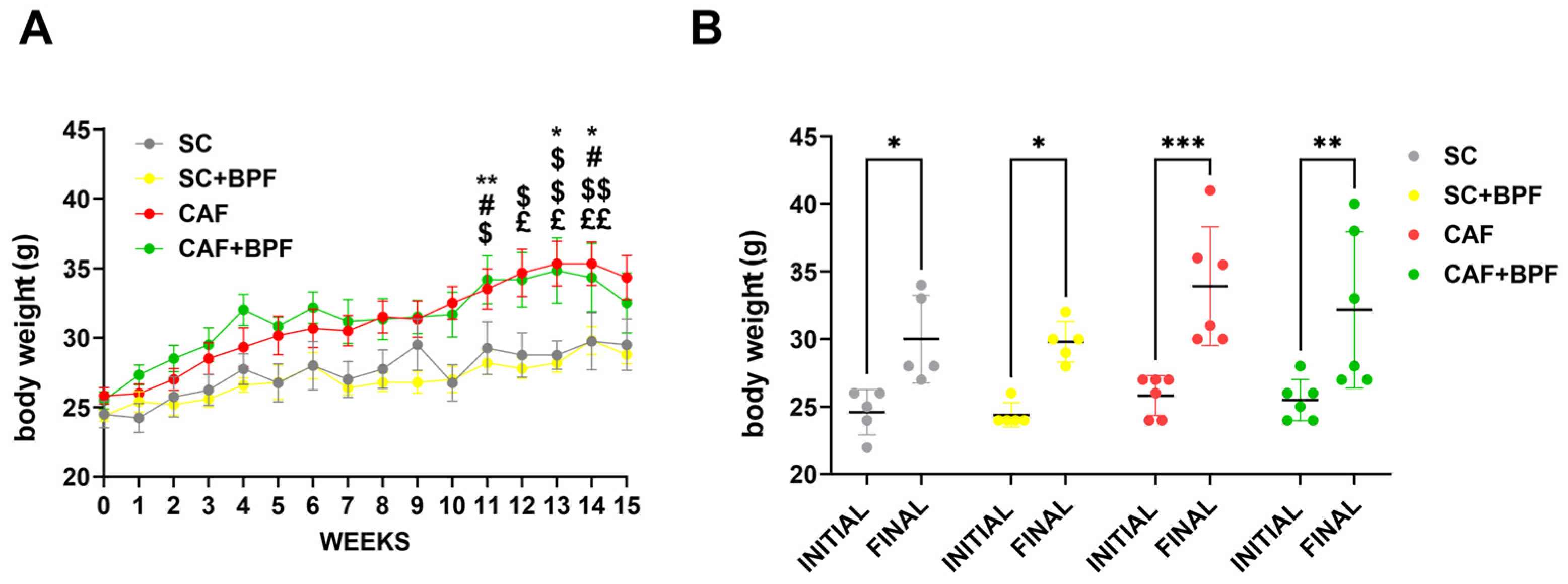

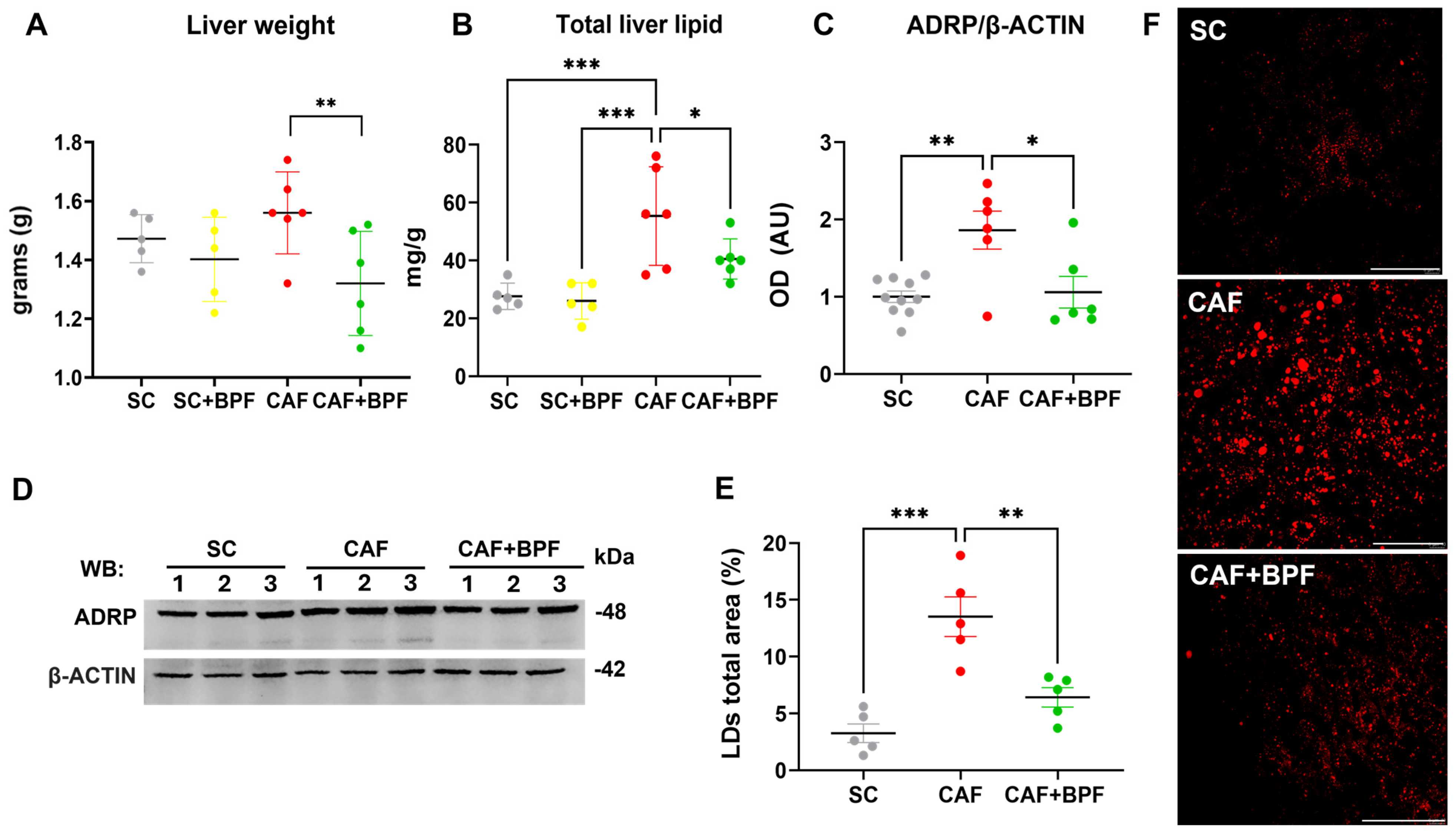

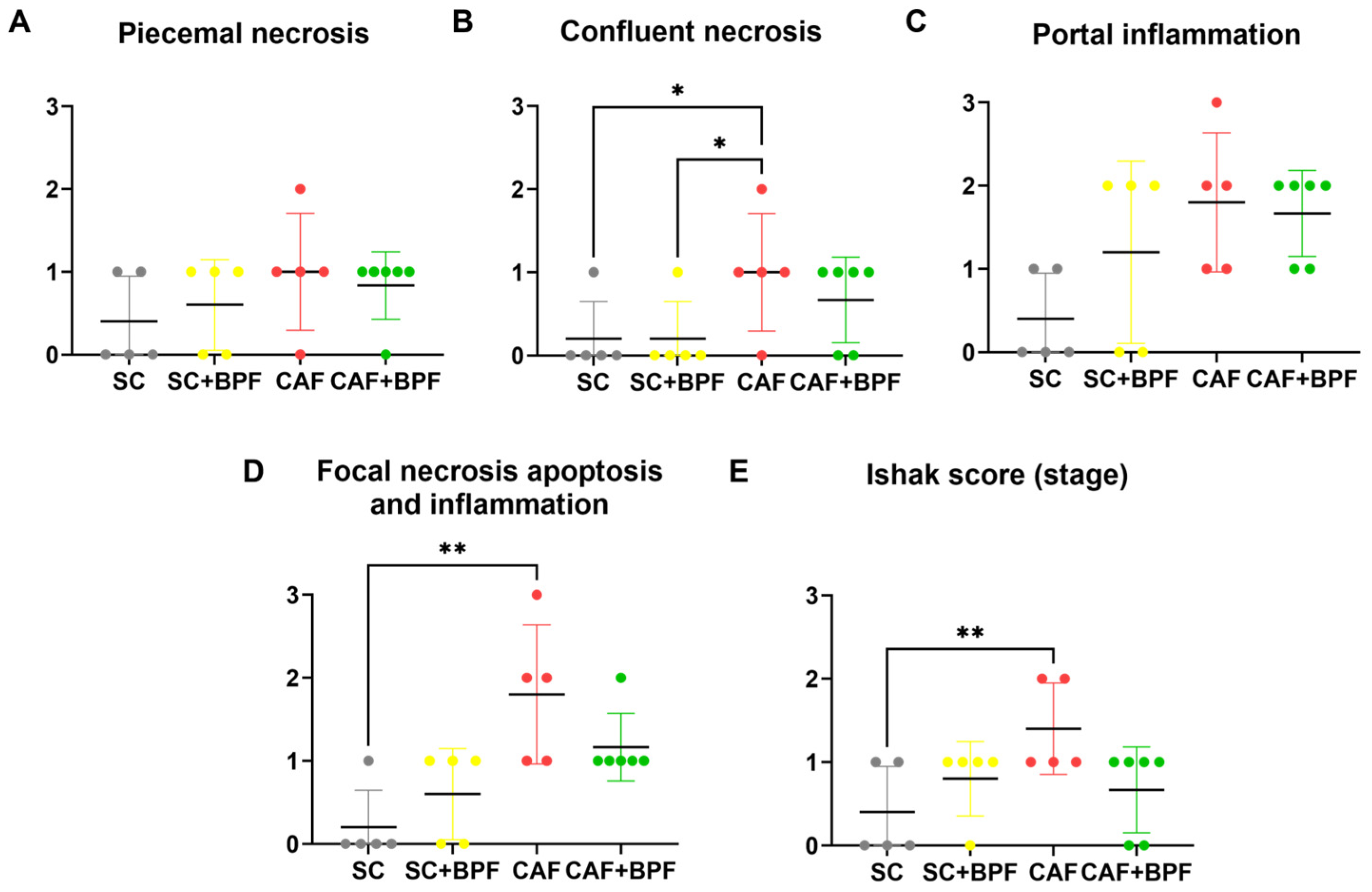
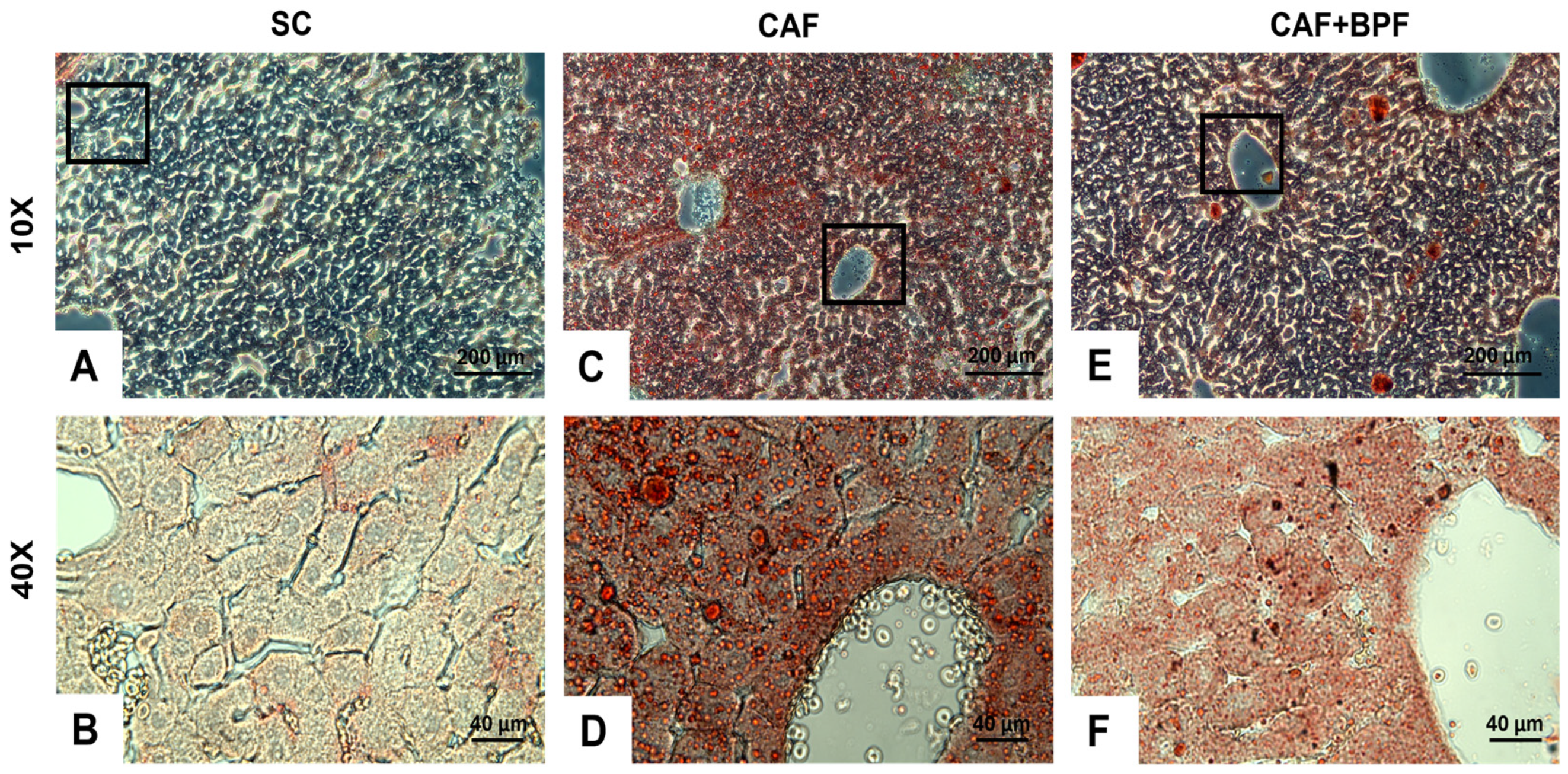
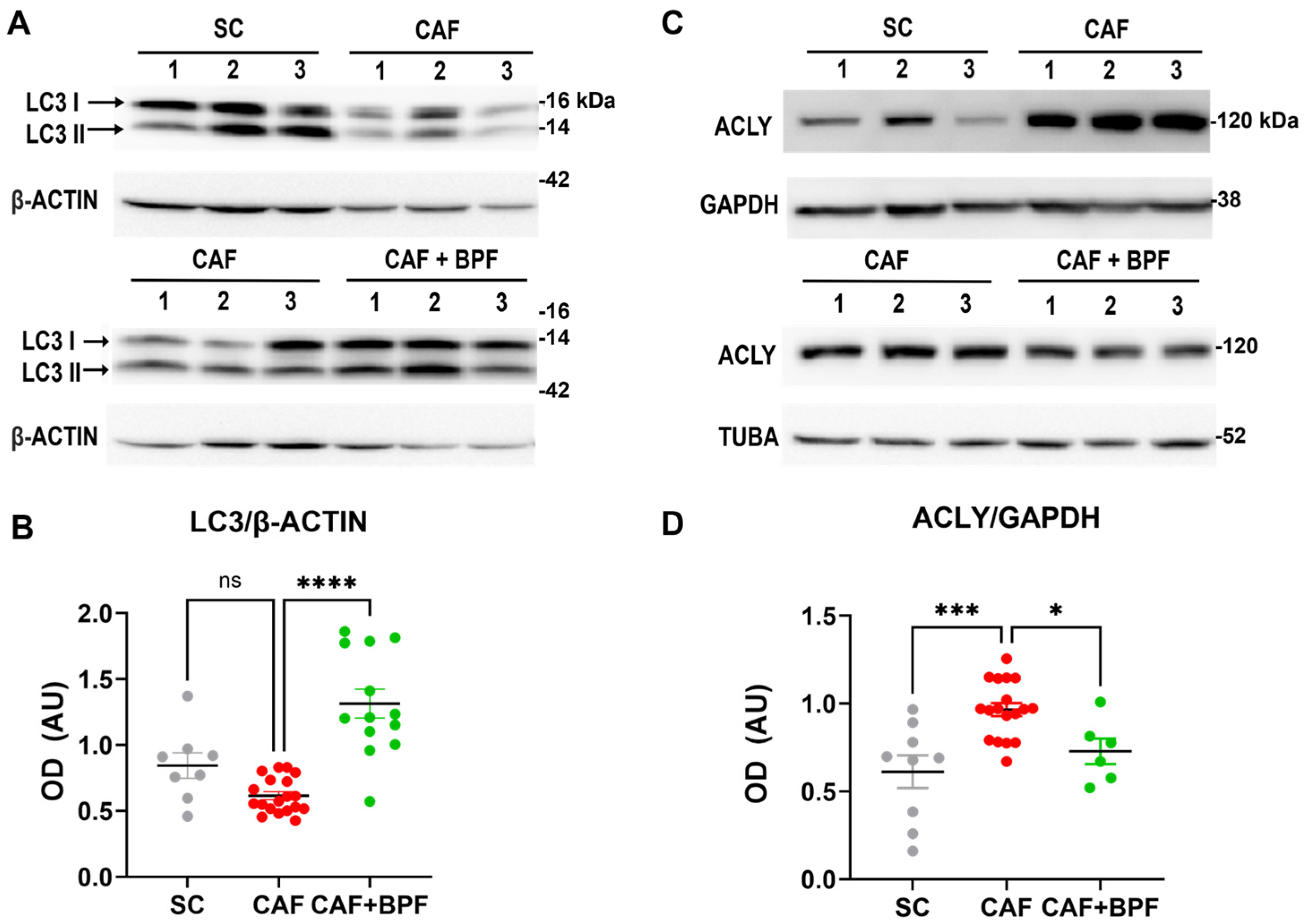
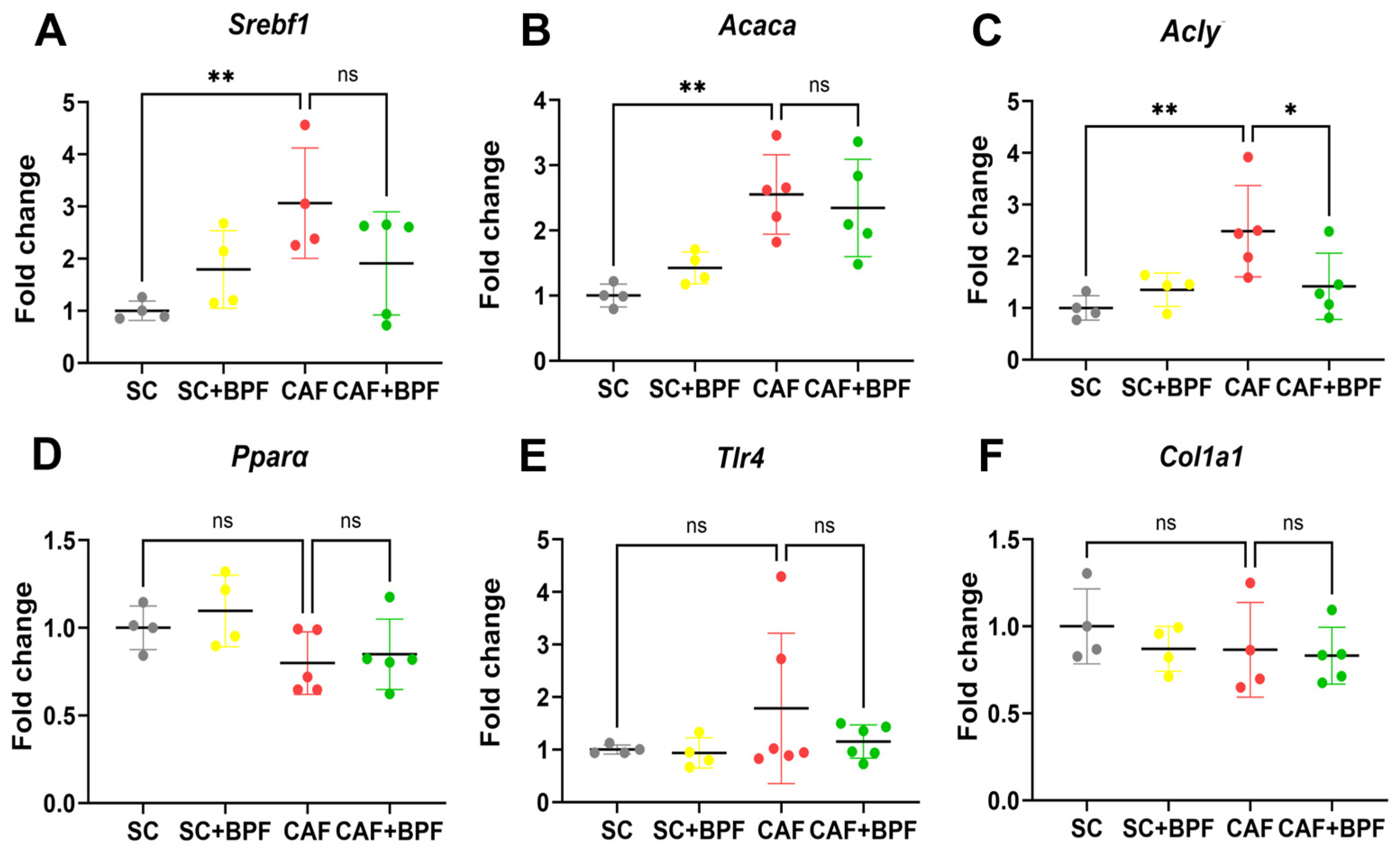
| SCFAs Concentrations in Caecal Digesta | |||||||||||
|---|---|---|---|---|---|---|---|---|---|---|---|
| Group | ANOVA p Value | ||||||||||
| SC | SC+BPF | CAF | CAF+BPF | ||||||||
| SDs | SDs | SDs | SDs | a | b | c | |||||
| SCFAs µmol/g digesta | |||||||||||
| Total SCFA | 36.59 | ±8.48 a | 31.74 | ±5.89 b | 15.67 | ±11.12 abc | 37.77 | ±10.84 c | 0.005 | 0.033 | 0.004 |
| Acetic | 23.83 | ± 4.54 a | 19.62 | ±2.46 | 11.03 | ±7.37 ac | 24.37 | ±6.62 c | 0.004 | ns | 0.004 |
| Propionic | 5.98 | ±1.52 | 6.12 | ±1.57 | 2.89 | ±2.33 c | 6.97 | ±2.52 c | ns | ns | 0.016 |
| Butyric | 6.78 | ±3.71 a | 5.99 | ±2.47 | 1.75 | ±1.64 ac | 6.43 | ±2.70 c | 0.023 | ns | 0.048 |
| Iso-butyric | 0.34 | ±0.11 | 0.52 | ±0.18 | 0.58 | ±0.07 | 0.31 | ±0.16 | ns | ns | ns |
| Iso-valeric | 0.36 | ±0.16 | 0.60 | ±0.22 b | 0.32 | ±0.21 | 0.27 | ±0.16 b | ns | 0.048 | ns |
| Valeric | 0.46 | ±0.12 | 0.47 | ±0.12 | 0.37 | ±0.20 | 0.43 | ±0.13 | ns | ns | ns |
| PSCFA | 1.16 | ±0.39 | 1.59 | ±0.52 | 1.27 | ±0.48 | 1.01 | ±0.45 | ns | ns | ns |
| % of total SCFAs | |||||||||||
| Acetic | 65.53 | ±3.96 | 62.56 | ±5.80 b | 73.97 | ±8.912 | 65.42 | ±6.93 b | ns | 0.035 | ns |
| Propionic | 16.54 | ±3.82 | 19.14 | ±2.36 | 17.01 | ±4.16 | 18.08 | ±4.01 | ns | ns | ns |
| Butyric | 17.93 | ±5.64 a | 18.31 | ±4.50 b | 9.02 | ±5.30 ab | 16.50 | ±4.63 | 0.031 | 0.023 | ns |
Disclaimer/Publisher’s Note: The statements, opinions and data contained in all publications are solely those of the individual author(s) and contributor(s) and not of MDPI and/or the editor(s). MDPI and/or the editor(s) disclaim responsibility for any injury to people or property resulting from any ideas, methods, instructions or products referred to in the content. |
© 2025 by the authors. Licensee MDPI, Basel, Switzerland. This article is an open access article distributed under the terms and conditions of the Creative Commons Attribution (CC BY) license (https://creativecommons.org/licenses/by/4.0/).
Share and Cite
Riillo, C.; Parafati, M.; Crupi, F.; Fotschki, B.; Ragusa, M.; Di Vito, A.; Mignogna, C.; Mollace, V.; Janda, E. Bergamot Polyphenols Reduce Hepatic Lipogenesis While Boosting Autophagy and Short-Chain Fatty Acid Production in a Murine “Cafeteria” Model of MASLD. Nutrients 2025, 17, 3684. https://doi.org/10.3390/nu17233684
Riillo C, Parafati M, Crupi F, Fotschki B, Ragusa M, Di Vito A, Mignogna C, Mollace V, Janda E. Bergamot Polyphenols Reduce Hepatic Lipogenesis While Boosting Autophagy and Short-Chain Fatty Acid Production in a Murine “Cafeteria” Model of MASLD. Nutrients. 2025; 17(23):3684. https://doi.org/10.3390/nu17233684
Chicago/Turabian StyleRiillo, Concetta, Maddalena Parafati, Francesco Crupi, Bartosz Fotschki, Monica Ragusa, Anna Di Vito, Chiara Mignogna, Vincenzo Mollace, and Elzbieta Janda. 2025. "Bergamot Polyphenols Reduce Hepatic Lipogenesis While Boosting Autophagy and Short-Chain Fatty Acid Production in a Murine “Cafeteria” Model of MASLD" Nutrients 17, no. 23: 3684. https://doi.org/10.3390/nu17233684
APA StyleRiillo, C., Parafati, M., Crupi, F., Fotschki, B., Ragusa, M., Di Vito, A., Mignogna, C., Mollace, V., & Janda, E. (2025). Bergamot Polyphenols Reduce Hepatic Lipogenesis While Boosting Autophagy and Short-Chain Fatty Acid Production in a Murine “Cafeteria” Model of MASLD. Nutrients, 17(23), 3684. https://doi.org/10.3390/nu17233684








